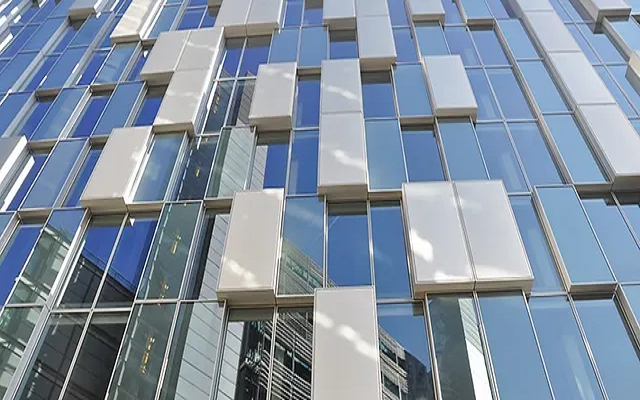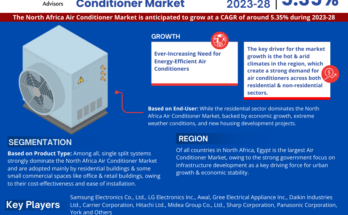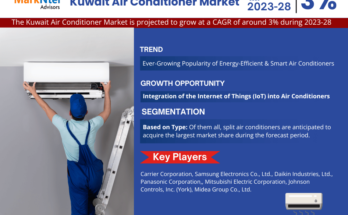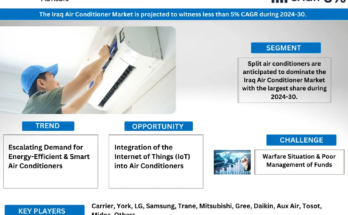Global Facade Market has valued at USD 201.08 billion in 2022 and is anticipated to project robust growth in the forecast period with a CAGR of 5.19% through 2028. The global facade market refers to the comprehensive and dynamic industry that encompasses the design, manufacture, installation, and maintenance of building facades or exteriors. Facades are the visible outer shells of structures, serving as the interface between a building’s interior and its external environment.
This market plays a pivotal role in modern construction and architecture, shaping the aesthetic, functional, and environmental aspects of buildings. Key components of the global facade market include a wide range of materials (such as glass, aluminum, stone, and composite panels), innovative technologies (including smart and dynamic facade systems), and architectural designs. Facades are not merely decorative elements; they significantly impact a building’s energy efficiency, safety, and overall sustainability.
Driven by factors such as urbanization, sustainability concerns, technological advancements, and regulatory compliance, the global facade market is marked by constant innovation. It responds to evolving architectural trends, environmental regulations, and economic conditions. This market’s diverse landscape comprises manufacturers, designers, contractors, and other stakeholders who collaborate to create structures that are not only visually appealing but also energy-efficient, safe, and environmentally responsible. In essence, the global facade market shapes the exterior face of our built environment, reflecting the aspirations of contemporary design and construction practices.
Key Market Drivers
Sustainability and Energy Efficiency
Sustainability and energy efficiency are paramount drivers in the global facade market. As the world grapples with climate change and the need to reduce carbon emissions, the construction industry is under increasing pressure to adopt environmentally friendly practices. Facades play a crucial role in achieving this goal by optimizing a building’s energy performance. High-performance facade systems, such as those incorporating energy-efficient glass, advanced insulation materials, and smart technologies, help reduce energy consumption and decrease greenhouse gas emissions. As governments and organizations worldwide implement stricter environmental regulations and incentivize sustainable construction practices, the demand for eco-friendly facades continues to surge.
Download FREE Sample Report @ https://www.techsciresearch.com/sample-report.aspx?cid=15976
Urbanization and Population Growth
Urbanization and population growth are driving forces behind the growth of the global facade market. As more people flock to urban centers in search of better opportunities, the demand for residential, commercial, and mixed-use buildings is on the rise. This rapid urbanization necessitates innovative facade solutions to optimize space utilization in densely populated areas. Furthermore, aging urban infrastructure often requires facade renovation and retrofitting, creating additional opportunities for market growth. The urbanization trend is expected to persist, further propelling the facade market forward.
Technological Advancements
Technological advancements are reshaping the facade industry. New materials, such as smart glass and dynamic facade systems, are revolutionizing building exteriors. Smart facades can adapt to environmental conditions, enhancing energy efficiency and occupant comfort. Additionally, simulation and modeling tools, coupled with Building Information Modeling (BIM), enable architects and engineers to design facades that meet stringent performance criteria. Augmented Reality (AR) and Virtual Reality (VR) technologies aid in visualization and decision-making processes, fostering efficiency in design and construction. These technological advances are not only enhancing the functionality of facades but also driving demand for cutting-edge solutions in the global market.
Architectural Trends and Aesthetics
Architectural trends and aesthetics are key drivers shaping the global facade market. In contemporary architecture, facades serve as iconic expressions of a building’s identity. Architects are pushing creative boundaries, experimenting with novel materials, textures, and forms to achieve unique and visually captivating facades. The desire for distinctive and aesthetically pleasing designs is driving demand for customized facade solutions. Building owners and developers are increasingly recognizing the value of facades as branding opportunities, further fueling the market’s growth.
Regulatory Compliance and Safety
Regulatory compliance and safety standards are critical drivers in the facade market. Governments and regulatory bodies around the world are intensifying their focus on building safety, especially in the wake of high-profile fire incidents. Facade materials and systems must meet stringent fire-resistant and safety requirements. Moreover, energy efficiency regulations are becoming more stringent, necessitating the adoption of advanced facade technologies to enhance building performance. Compliance with these regulations is not only mandatory but also a selling point for developers and property owners, driving growth in the global facade market.
Economic Factors and Real Estate Development
Economic factors, including GDP growth, real estate development, and construction activities, significantly impact the facade market. Economic prosperity drives investment in residential, commercial, and infrastructure projects—all of which require facades. Trends in real estate, such as the development of mixed-use properties and luxury buildings, influence facade design and demand for high-quality materials. While economic downturns can temporarily slow construction activity, long-term urbanization and population growth trends typically sustain the demand for facades, making economic factors a crucial driver of the global facade market.
In conclusion, the global facade market is driven by a complex interplay of sustainability, urbanization, technology, aesthetics, regulations, and economic conditions. These drivers collectively contribute to the industry’s growth and evolution, making it a dynamic and vital component of the construction and architectural sectors.
Government Policies are Likely to Propel the Market
Building Energy Efficiency Standards
Building energy efficiency standards are critical government policies that have a substantial impact on the global facade market. These standards mandate the energy performance of buildings, including the efficiency of their facades. Governments worldwide are increasingly recognizing the importance of reducing energy consumption and greenhouse gas emissions from buildings. To achieve these goals, they implement stringent energy codes and regulations that require building facades to meet specific performance criteria. These criteria often include insulation requirements, window performance standards, and air leakage limits, all of which influence the design and construction of facades. These policies drive demand for energy-efficient facade materials and technologies, such as high-performance glazing, advanced insulation materials, and smart facade systems. The global facade market responds to these policies by offering innovative solutions that help building owners and developers comply with energy efficiency standards while reducing operational costs and environmental impact.
Safety and Building Codes
Government policies related to safety and building codes play a crucial role in shaping the global facade market. These policies are designed to ensure the safety of occupants and protect property against various hazards, including fires, earthquakes, and extreme weather events. Facades are subject to strict regulations concerning fire resistance, structural integrity, and wind load capacity. To comply with these policies, the facade industry must provide materials and systems that meet or exceed safety standards. This drives research and development efforts to create fire-resistant cladding materials, impact-resistant glass, and earthquake-resistant facade systems. Government oversight and enforcement of building codes also create a demand for inspections and certification services, further influencing the global facade market.
Environmental Regulations and Sustainability Initiatives
Environmental regulations and sustainability initiatives are pivotal government policies affecting the global facade market. Governments worldwide are increasingly focused on addressing climate change and promoting sustainable building practices. As a result, policies and incentives are established to encourage the use of environmentally friendly facade materials and designs. These policies drive demand for sustainable facade solutions such as green roofs, photovoltaic panels, and energy-efficient glazing. Governments may offer tax incentives, rebates, or grants to encourage building owners and developers to adopt sustainable facades, fostering growth in the green building sector. The global facade market responds by developing and promoting sustainable facade options that align with these policies, contributing to a more eco-conscious construction industry.
Import and Export Regulations
Import and export regulations imposed by governments have a significant impact on the global facade market, particularly in regions where international trade is a major component of the industry. These regulations encompass tariffs, duties, quality standards, and certification requirements for facade materials and components. Government policies can either facilitate or hinder the flow of facade materials and technologies across borders. Trade agreements and partnerships can lead to easier access to international markets, fostering competition and innovation in the facade industry. Conversely, protectionist policies may restrict imports, leading to a focus on domestic production and the development of alternative materials and technologies.
Tax Incentives and Subsidies
Tax incentives and subsidies offered by governments can be powerful drivers of the global facade market. These policies are designed to promote specific economic activities or achieve social objectives. In the context of facades, governments may provide tax credits or financial incentives to encourage energy-efficient or sustainable building practices. For example, tax credits for installing energy-efficient windows or solar panels on facades can stimulate demand for these products. Such policies incentivize building owners and developers to invest in high-performance facades, ultimately reducing energy consumption and environmental impact.
Infrastructure Investment
Government infrastructure investment policies have a direct impact on the global facade market, particularly in the context of public infrastructure projects. When governments allocate substantial funds for infrastructure development, including the construction of government buildings, transportation hubs, and public facilities, there is a significant demand for facade materials and systems. The design and construction of these projects often require high-quality and visually appealing facades that meet specific performance criteria. As a result, the facade market responds by offering innovative solutions tailored to meet the needs of these government-funded projects.
In conclusion, government policies have a profound influence on the global facade market, shaping demand for specific materials, technologies, and design approaches. Facade industry players must navigate and adapt to these policies to remain competitive in the ever-evolving construction and architectural sectors.
Key Market Challenges
Cost Pressures and Budget Constraints
One of the primary challenges confronting the global facade market is the persistent pressure to reduce costs and the prevalence of budget constraints. Building owners, developers, and construction companies consistently seek cost-effective solutions to maximize their return on investment. This has a direct impact on the facade industry as clients often prioritize projects that offer cost savings in the short term. One aspect of cost pressure is the demand for competitive pricing on facade materials and systems. To secure contracts, facade suppliers are often compelled to lower their prices, potentially compromising on the quality of materials or manufacturing processes. This competitive pricing can lead to reduced profit margins, making it difficult for companies to invest in research and development efforts to innovate and improve their products. Additionally, budget constraints can hinder the adoption of advanced facade technologies and sustainable materials. Energy-efficient facade systems, for example, may require a higher upfront investment but offer long-term savings in operational costs. However, many clients are hesitant to commit to these upfront costs, which can slow the adoption of innovative and environmentally friendly facade solutions. Moreover, the challenge of cost pressures is exacerbated by fluctuations in the prices of raw materials, labor, and other production-related factors. These market dynamics can make it challenging for facade manufacturers to maintain consistent pricing and profitability. To address this challenge, companies in the global facade market must focus on cost-effective manufacturing processes, efficient supply chain management, and value engineering without compromising quality and performance. Additionally, educating clients about the long-term benefits of sustainable and energy-efficient facades can help overcome budget constraints by demonstrating the potential return on investment over time.
Rapid Technological Advancements and Adaptation
While technological advancements can be a driver of growth in the facade market, they also present a significant challenge. The pace at which technology is evolving is sometimes difficult for the industry to keep up with, leading to concerns about obsolescence and the need for constant adaptation. For example, the integration of smart technologies in facades, such as dynamic glass systems and automated shading, is becoming more commonplace. However, staying current with these technologies and ensuring compatibility with existing building management systems can be challenging for both manufacturers and building owners. Additionally, the increasing complexity of facade designs and the use of cutting-edge materials require specialized knowledge and skills in both design and construction. Ensuring that architects, engineers, and construction teams are adequately trained and up-to-date with the latest techniques and technologies can be a logistical challenge. Moreover, as sustainability and energy efficiency standards continue to evolve, facade manufacturers must continually innovate to meet stricter requirements. This can entail investments in research and development to develop new materials and systems that meet these standards, which can be financially taxing.
To address this challenge, collaboration between industry stakeholders, including manufacturers, architects, contractors, and educational institutions, is crucial. Facade manufacturers must also invest in ongoing research and development efforts to stay at the forefront of technological advancements, ensuring that their products remain competitive and compliant with evolving industry standards. Additionally, providing training and knowledge-sharing opportunities can help professionals in the facade market adapt to new technologies and design trends more effectively.
Related Reports
Plastic Hot & Cold Pipe Market Outlook & Forecast [2028]
Bulletproof Glass Market [2028] – Trends, Share & Forecast
Fiber Cement Market – Opportunities, Size & Growth [2028]
Table of Content-Facade Market
- Product Overview
- Research Methodology
- Executive Summary
- Voice of Customer
- Global Facade Market Outlook
5.1. Market Size & Forecast
5.1.1. By Value
5.2. Market Share & Forecast
5.2.1. By Product (Ventilated and Non-Ventilated)
5.2.2. By Type of Facade (Steel, Panel Frame, Curtain Wall, Clay, Aluminum Composite, Precast Concrete)
5.2.3. By Building Type (Industrial, Residential, Commercial)
5.2.4. By Region
5.2.5. By Company (2022)
5.3. Market Map
- North America Facade Market Outlook
6.1. Market Size & Forecast
6.1.1. By Value
6.2. Market Share & Forecast
6.2.1. By Product
6.2.2. By Type of Façade
6.2.3. By Building Type
6.2.4. By Country
6.3. North America: Country Analysis
6.3.1. United States Facade Market Outlook
6.3.1.1. Market Size & Forecast
6.3.1.1.1. By Value
6.3.1.2. Market Share & Forecast
6.3.1.2.1. By Product
6.3.1.2.2. By Type of Façade
6.3.1.2.3. By Building Type
6.3.2. Canada Facade Market Outlook
6.3.2.1. Market Size & Forecast
6.3.2.1.1. By Value
6.3.2.2. Market Share & Forecast
6.3.2.2.1. By Product
6.3.2.2.2. By Type of Façade
6.3.2.2.3. By Building Type
6.3.3. Mexico Facade Market Outlook
6.3.3.1. Market Size & Forecast
6.3.3.1.1. By Value
6.3.3.2. Market Share & Forecast
6.3.3.2.1. By Product
6.3.3.2.2. By Type of Façade
6.3.3.2.3. By Building Type
- Europe Facade Market Outlook
7.1. Market Size & Forecast
7.1.1. By Value
7.2. Market Share & Forecast
7.2.1. By Product
7.2.2. By Type of Façade
7.2.3. By Building Type
7.2.4. By Country
7.3. Europe: Country Analysis
7.3.1. Germany Facade Market Outlook
7.3.1.1. Market Size & Forecast
7.3.1.1.1. By Value
7.3.1.2. Market Share & Forecast
7.3.1.2.1. By Product
7.3.1.2.2. By Type of Façade
7.3.1.2.3. By Building Type
7.3.2. United Kingdom Facade Market Outlook
7.3.2.1. Market Size & Forecast
7.3.2.1.1. By Value
7.3.2.2. Market Share & Forecast
7.3.2.2.1. By Product
7.3.2.2.2. By Type of Façade
7.3.2.2.3. By Building Type
7.3.3. Italy Facade Market Outlook
7.3.3.1. Market Size & Forecast
7.3.3.1.1. By Value
7.3.3.2. Market Share & Forecast
7.3.3.2.1. By Product
7.3.3.2.2. By Type of Façade
7.3.3.2.3. By Building Type
7.3.4. France Facade Market Outlook
7.3.4.1. Market Size & Forecast
7.3.4.1.1. By Value
7.3.4.2. Market Share & Forecast
7.3.4.2.1. By Product
7.3.4.2.2. By Type of Façade
7.3.4.2.3. By Building Type
7.3.5. Spain Facade Market Outlook
7.3.5.1. Market Size & Forecast
7.3.5.1.1. By Value
7.3.5.2. Market Share & Forecast
7.3.5.2.1. By Product
7.3.5.2.2. By Type of Façade
7.3.5.2.3. By Building Type
- Asia-Pacific Facade Market Outlook
8.1. Market Size & Forecast
8.1.1. By Value
8.2. Market Share & Forecast
8.2.1. By Product
8.2.2. By Type of Façade
8.2.3. By Building Type
8.2.4. By Country
8.3. Asia-Pacific: Country Analysis
8.3.1. China Facade Market Outlook
8.3.1.1. Market Size & Forecast
8.3.1.1.1. By Value
8.3.1.2. Market Share & Forecast
8.3.1.2.1. By Product
8.3.1.2.2. By Type of Façade
8.3.1.2.3. By Building Type
8.3.2. India Facade Market Outlook
8.3.2.1. Market Size & Forecast
8.3.2.1.1. By Value
8.3.2.2. Market Share & Forecast
8.3.2.2.1. By Product
8.3.2.2.2. By Type of Façade
8.3.2.2.3. By Building Type
8.3.3. Japan Facade Market Outlook
8.3.3.1. Market Size & Forecast
8.3.3.1.1. By Value
8.3.3.2. Market Share & Forecast
8.3.3.2.1. By Product
8.3.3.2.2. By Type of Façade
8.3.3.2.3. By Building Type
8.3.4. South Korea Facade Market Outlook
8.3.4.1. Market Size & Forecast
8.3.4.1.1. By Value
8.3.4.2. Market Share & Forecast
8.3.4.2.1. By Product
8.3.4.2.2. By Type of Façade
8.3.4.2.3. By Building Type
8.3.5. Australia Facade Market Outlook
8.3.5.1. Market Size & Forecast
8.3.5.1.1. By Value
8.3.5.2. Market Share & Forecast
8.3.5.2.1. By Product
8.3.5.2.2. By Type of Façade
8.3.5.2.3. By Building Type
- South America Facade Market Outlook
9.1. Market Size & Forecast
9.1.1. By Value
9.2. Market Share & Forecast
9.2.1. By Product
9.2.2. By Type of Façade
9.2.3. By Building Type
9.2.4. By Country
9.3. South America: Country Analysis
9.3.1. Brazil Facade Market Outlook
9.3.1.1. Market Size & Forecast
9.3.1.1.1. By Value
9.3.1.2. Market Share & Forecast
9.3.1.2.1. By Product
9.3.1.2.2. By Type of Façade
9.3.1.2.3. By Building Type
9.3.2. Argentina Facade Market Outlook
9.3.2.1. Market Size & Forecast
9.3.2.1.1. By Value
9.3.2.2. Market Share & Forecast
9.3.2.2.1. By Product
9.3.2.2.2. By Type of Façade
9.3.2.2.3. By Building Type
9.3.3. Colombia Facade Market Outlook
9.3.3.1. Market Size & Forecast
9.3.3.1.1. By Value
9.3.3.2. Market Share & Forecast
9.3.3.2.1. By Product
9.3.3.2.2. By Type of Façade
9.3.3.2.3. By Building Type




